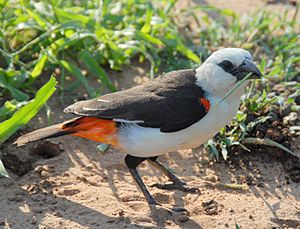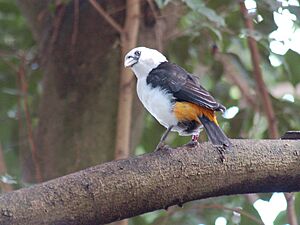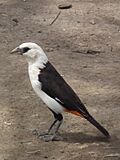White-headed buffalo weaver facts for kids
Quick facts for kids White-headed buffalo weaver |
|
|---|---|
 |
|
| D. d. boehmi Serengeti National Park, Tanzania |
|
| Conservation status | |
| Scientific classification |
The white-headed buffalo weaver (Dinemellia dinemelli) is a type of bird that lives in East Africa. It's called 'buffalo weaver' because it often follows African buffalo. It eats insects that the buffalo stir up from the ground as they walk. There are two main types of this bird.
Contents
Meet the White-Headed Buffalo Weaver
This bird was first described by a German scientist named Eduard Rüppell in 1845.
Different Types of White-Headed Buffalo Weavers
There are two recognized types, or subspecies, of the white-headed buffalo weaver:
What Does the White-Headed Buffalo Weaver Look Like?
The white-headed buffalo weaver is about 17 to 19 centimeters (7 to 7.5 inches) long. It weighs between 57 and 85 grams (2 to 3 ounces). It has a bright white head and white belly. Its lower back and the feathers under its tail are a vivid orange-red. Its upper legs are dark brown. You might see narrow white bands on its wings, especially when it stretches them out.
Both male and female birds look very similar. Their beaks are black and shaped like a cone. The D. d. dinemelli type has a brown tail, while the D. d. boehmi type has a black tail.
Where Do White-Headed Buffalo Weavers Live?
These birds are found in several African countries. These include Ethiopia, Kenya, Somalia, Sudan, Tanzania, and Uganda. They like to live in places with lots of dry bushes and acacia trees. They also enjoy savanna areas.
How Do White-Headed Buffalo Weavers Behave?

Like most weaver birds, they are very social. They often look for food on the ground in groups of 3 to 6 birds. They eat insects, especially beetles and butterflies, as well as fruits and seeds. Sometimes, they even forage with starlings.
They make many different sounds. Some of their calls sound like a parrot, such as "skwieeer" or "kiiyerr." They also make a ringing, repeated "tew" sound. When they are at their nesting or roosting spots, you might hear chuckles and whistles. These sounds are often slow and drawn out. They also make trilling sounds like "tsu-weely-weely-wair."
These birds often perch in trees and can even hang upside down! They can be quite noisy. They live and nest in groups and will make a lot of noise to defend their area from other birds. Fights are usually just loud and rarely cause harm.
When a male wants to attract a female, he spreads his wings. This shows off his white wing patches and his bright red-orange tail feathers.
Reproduction and Life Cycle
White-headed buffalo weavers form pairs and stay together. They build their nests together. The time they breed depends on when it rains in their area.
Their nests are large and oval-shaped, about 57 centimeters (22 inches) wide. They build them by pushing materials together, not weaving them tightly. A short entrance tube points downwards. The nest is usually 2 to 4 meters (6.5 to 13 feet) above the ground. The inside of the nest is lined with soft materials and has several rooms. The outside is covered with thorny branches to protect it.
A single large tree can hold many of their nests. Other birds, like the African pygmy-falcon, sometimes use these nests instead of building their own. The female bird lays 3 to 5 eggs. The eggs are grayish to pale blue with red, brown, and olive markings. She sits on the eggs for 11 to 14 days. Both parents help feed the baby birds.




